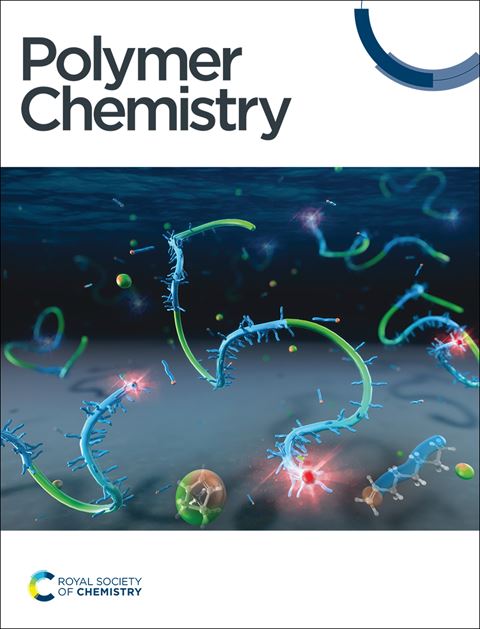通过接枝到方法生成拓扑定义的线性和环状DNA瓶刷聚合物
IF 4.1
2区 化学
Q2 POLYMER SCIENCE
引用次数: 0
摘要
在此,我们报告了一种接枝合成线性和圆形双链DNA (dsDNA)瓶刷聚合物(BBP)的方法。利用生物反应器,质粒DNA (pDNA)可作为循环、可生物降解和单分子聚合物的廉价和丰富的来源。通过酶的限制,pDNA很容易转化为线性同工异构体,提供了具有不同拓扑状态的聚合物骨架。DNA与聚乙二醇单甲基醚氯乙胺(mPEGCEA)接枝以产生DNA BBPs。重要的是,这种聚乙二醇化在水缓冲液的环境条件下迅速发生。通过改变mPEGCEA的分子量(Mw = 750, 2000, 5000 Da)和相对于µmol的核苷酸浓度,可以获得不同的刷臂密度和长度。通过琼脂糖凝胶电泳对DNA BBPs进行分析,结果显示线性DNA和环状DNA的接枝密度分别高达68.7%和74.8%。接枝过程不改变碱基配对或圆,用原子力显微镜确定。剪切流变学用于比较1% wt / wt环状和线性DNA BBPs溶液与其未烷基化形式的力学响应。与线性DNA相比,线性DNA BBPs表现出更低的剪切模量,这是由于与聚合物臂的附着相关的持续长度增加和互穿能力降低。然而,与烷基化样品相比,环状DNA BBPs普遍表现出更高的剪切模量,这表明通过添加聚合物臂增加了链间相互作用。最后,DNA BBPs的空间负担的增加减缓了酶降解,潜在地提供了一种提高DNA结构对核酸酶稳定性的通用方法。本文章由计算机程序翻译,如有差异,请以英文原文为准。
Generation of Topologically Defined Linear and Cyclic DNA Bottle Brush Polymers via a Graft-to Approach
Herein, we report a graft-to approach for synthesizing linear and circular double-stranded DNA (dsDNA) bottlebrush polymers (BBP). Using a bioreactor, plasmid DNA (pDNA) serves as an inexpensive and abundant source of circular, biodegradable, and unimolecular polymers. pDNA is easily converted to the linear isoform through enzymatic restriction, providing access to polymeric backbones with distinct topological states. DNA is grafted with polyethylene glycol monomethyl ether chloroethylamines (mPEGCEA) to yield DNA BBPs. Importantly this PEGylation occurs rapidly under ambient conditions in aqueous buffer. By varying the molecular weight of mPEGCEA (Mw = 750, 2000, 5000 Da) and the concentration relative to µmol of nucleotides, different brush arm densities and lengths were achieved with both linear and macrocyclic DNA backbones. Analysis of the DNA BBPs was achieved through agarose gel electrophoresis, which showed graft densities of up to 68.7% and 74.8% for linear and ring DNA respectively. The grafting process does not alter base pairing or circularity as determined using atomic force microscopy. Shear rheology was used to compare the mechanical response of 1% wt / wt solutions of the ring and linear DNA BBPs to their un-alkylated forms. Linear DNA BBPs exhibited a lower shear modulus versus linear DNA, which is expected due to the increased persistence length and decreased ability to interpenetrate associated with the attachment of polymer arms. However, the circular DNA BBPs exhibited a universally higher shear modulus versus the alkylated sample suggesting an increase in interchain interaction via addition of polymer arms. Finally, the increased steric encumbrance of the DNA BBPs slows enzymatic degradation, potentially providing a general method to increase stability of DNA constructs towards nuclease.
求助全文
通过发布文献求助,成功后即可免费获取论文全文。
去求助
来源期刊

Polymer Chemistry
POLYMER SCIENCE-
CiteScore
8.60
自引率
8.70%
发文量
535
审稿时长
1.7 months
期刊介绍:
Polymer Chemistry welcomes submissions in all areas of polymer science that have a strong focus on macromolecular chemistry. Manuscripts may cover a broad range of fields, yet no direct application focus is required.
 求助内容:
求助内容: 应助结果提醒方式:
应助结果提醒方式:


